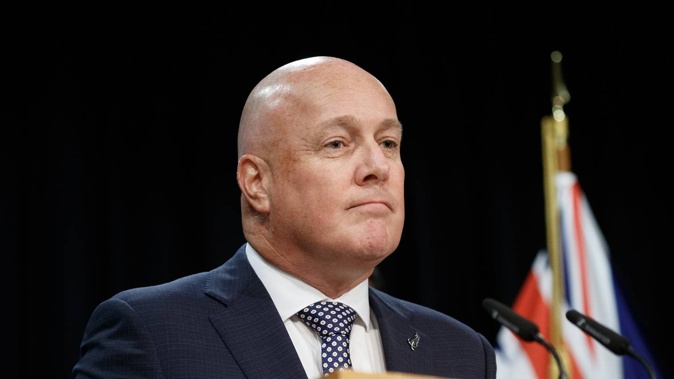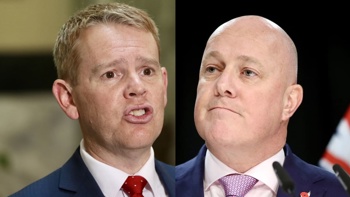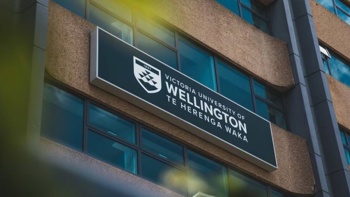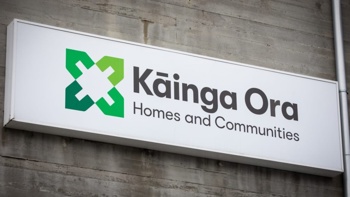
Prime Minister Christopher Luxon is flying commercially to Australia this morning.
A fault was found with the New Zealand Defence Force Boeing 757 jet he was due to fly on.
The Boeing is still intended to fly to Australia, carrying a travelling delegation and to fly Luxon home.
/cloudfront-ap-southeast-2.images.arcpublishing.com/nzme/FJWFAKOZPNDUVMEBMWXUMMGUUE.jpg) A fault was found in the NZDF plane shortly before it was due to take off this morning. Photo / Thomas Coughlan
A fault was found in the NZDF plane shortly before it was due to take off this morning. Photo / Thomas Coughlan
It is unclear what the fault is. Defence Force says it was a maintenance fault found during a pre-flight check. At this stage, the plane is still expected to fly today. Luxon has opted for a commercial flight so that he can continue his packed programme of bilateral meetings.
Luxon will be flying on Air New Zealand - the airline he was at the helm of for seven years.
In 2023, the then-opposition leader criticised sending a second Air Force 757 to shadow the first when Chris Hipkins travelled to China.
“Clearly it’s a sign that the Air Force are concerned about the reliability of the first plane and we’ve seen instances of that now over a number of years,” Luxon said at the time.
He said the decision was for the Government and the Air Force, but seemed “inappropriate”.
But he would not commit to replacing the plane earlier than the 2028-2030 timeline currently planned for.
Luxon’s invite to Asean Summit
Luxon received an invitation from Prime Minister Anthony Albanese to attend the Asean-Australia Summit in Melbourne - a sign of the strong ties between the two PMs.
Leaders of the Association of Southeast Asian Nations, or Asean, are gathering in Melbourne for a special summit to commemorate 50 years of association between Australia and the group. Albanese has kindly invited Luxon and a New Zealand delegation along for the ride.
The airplane drama could impact Luxon’s schedule in Melbourne.
His first meeting is with Philippines President Ferdinand Marcos Jr. at 11.45am NZ time - about an hour and a half after the Defence Force flight was meant to land.
His next meeting was with Lao Prime Minister Sonexay Siphadone at 12.30 NZ time.
The gesture is appreciated in Wellington. With coalition talks scuppering Luxon’s plans to go to Apec last year, Luxon’s flying visit to Melbourne will mark his summit debut, giving him the opportunity to press the flesh with nine of the leaders from the bloc, which comprises 10 nations whose collective population is over 660 million. Luxon isn’t wasting the opportunity, packing in a marathon of bilateral meetings into a single day.
He’s scored meetings with leaders from the Philippines, Laos, Brunei, Malaysia, Thailand, Indonesia, Singapore and Timor Leste, as well as an invite to the gala dinner.
The bloc is vitally important to New Zealand. Two-way trade with Asean nations is worth nearly $30 billion, and is growing. The current Government wants to extend that further. When Luxon talks about New Zealand’s privileged geographic placement on the edge of the South Pacific, he’s talking about our proximity to the fast-growing Asean economies.
Former trade negotiator Stephen Jacobi told the Herald that with more than 660 million inhabitants, Asean was a crucial potential trading partner for New Zealand. Trade with the bloc was covered by the Asean-originated Regional Comprehensive Economic Partnership (RCEP) agreement, which included the Asean nations as well as the likes of China, Japan and South Korea.
However, there is a sense that New Zealand is not exploiting the full potential of the bloc. Trade with one of the fastest-growing economies in the region and the world, Indonesia, is growing substantially, but from a low base. Exports hit $1b in 2017 and doubled to $2b by 2023.
But it’s Singapore that is the real jewel of the relationship, with New Zealand importing $9.1b worth of goods and exporting $2.4b to the country last year, making it the most significant trading partner for both exports and imports from the bloc.
But the Singaporean story is not an altogether happy one, and in many ways only underlines some of the trade challenges of the relationship. New Zealand has a significant trade deficit with the bloc, importing far more than it exports.
New Zealand has had a substantial trade deficit with the bloc since at least 2015, but this has recently ballooned, doubling from about $4b in 2015 to $10b last year.
Much of this is driven by energy imports. Thanks to the closure of the Marsden Point oil refinery, New Zealand imports billions of dollars’ worth of refined fuels from the bloc, mainly from Singapore. These imports were worth just $2.3b in 2015. They are worth $5.9b now.
Luxon would love to add an export story to this import story. He is meeting with Indonesia’s outgoing President Joko Widodo, known as Jokowi.
Following elections last month, Jokowi’s son Gibran Rakabuming Raka will become the country’s next vice president, inaugurating a political dynasty for the family. Jacobi told the Herald that Indonesia had been “quite a hard market for New Zealand exporters”.
Jacobi said Indonesia was a market where Kiwi exporters had not always had the “best access”.
“They were slow to ratify RCEP. We only actually got some new market access as a result of that new RCEP negotiation. It has been harder, but that doesn’t mean to say we shouldn’t.”
The current Government, like its predecessor, is keen to explore options for trade diversification. The subtext of this is for New Zealand to avoid placing all of its export eggs in the increasingly volatile Chinese basket.
Jacobi, a former director of the NZ China Council, was frank: “Asean is not about to replace China”.
“It’s important not to get carried away as the previous government was wont to do from time to time,” he said.
“Nevertheless, it is in its own right a very significant market today and of one, you know, greater potential in the future because we have some very large populations with a large middle class that want to consume the products we’ve got to sell.”
Professor David Capie, director of the Centre for Strategic Studies at Victoria University, told the Herald the Asean bloc was at the centre of some of the world’s most pressing security challenges like the militarisation of the South China Sea, the future of Taiwan, and the civil war in Myanmar, an Asean member.
“New Zealand has an interest in how these are managed,” he said.
He said Asean countries had been balancing their relationships between China and the United States, and “trying to manage the sharper edges of competition”.
Capie said they would likely have insights for New Zealand.
“It’s hugely valuable to hear from people who have been long-time observers of these countries to see how they see these things tracking.”
Thomas Coughlan is Deputy Political Editor and covers politics from Parliament. He has worked for the Herald since 2021 and has worked in the press gallery since 2018.
Take your Radio, Podcasts and Music with you









